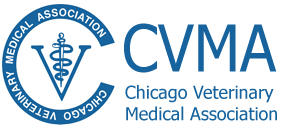Oral health is an essential component of the overall health and well being of your cat or dog. In recognition of February’s “Dental Health Awareness Month”, the Chicago Veterinary Medical Association offers the following home dental care advice to help keep your pet’s teeth in good shape in between annual veterinary dental exams and professional cleanings.
- While it is easiest to start brushing your pet’s teeth while young, proper dental care can be initiated at any age. Introduce your cat or dog to dental hygiene practices slowly and gradually. Dip a finger into beef bouillon (for dogs) or tuna water (for cats) and gently rub along your pet’s gums and teeth, focusing on the gum line, where bacteria and food mix to form plaque. Start at the front of the mouth, moving to the back upper and lower teeth and gum areas. Once your pet is comfortable with this little bit of touching, introduce gauze over your finger, rubbing the teeth and gums in a circular fashion.
- When your four-legged friend is accustomed to the gauze, try brushing with a toothbrush specially designed for pets, or a very soft, ultra-sensitive toothbrush designed for people. Bristles should be held at a 45-degree angle to the tooth surface and be moved in an oval motion. Remember to concentrate on the gum line and gradually introduce special dog/cat toothpaste. Never use human toothpaste or baking soda as both may upset your pet’s stomach
- To clean the inside surfaces of you pet’s teeth: o Place you hand over your pet’s muzzle from the top. o Gently squeeze and push the lips on one side between the back teeth (to keep the mouth open). o Pull the head back gently to open the mouth. o Brush the teeth on the opposite side and the repeat for the other side.
- The entire cleaning process should only take a minute or two. If your pet is resistant, try wrapping him/her in a large bath towel with only the head exposed. If you pet is reluctant to let you open his/her mouth, focus you efforts on the top row of teeth. As long as you can slip between the lip and teeth, and feel the gum line with your finger or toothbrush, you are in the right place. Above all, avoid overstraining and keep the session short and positive, with plenty of praise and reassurance.
- Feeding your pet dry food and offering hard biscuits after each meal can also help maintain good oral health as both help keep plaque to a minimum.
- Dental exams should be part of your annual veterinary visit. Regular cleanings by your veterinarian are also important for sound oral health. In addition, pet owners are encouraged to regularly examine their pet’s teeth for signs of periodontal disease, such as brownish colored teeth; swollen, red or bleeding gums; persistent bad breath; loose teeth or loss of teeth; pus between the gums and teeth; broken teeth or any unusual growth in the mouth. Reluctance to eat; play with chew toys; or drink cold water are also warning signs of periodontal or gum disease. Consult your veterinarian if you notice any of these signs in your pet.
